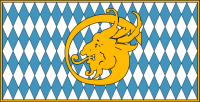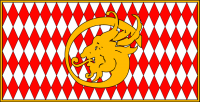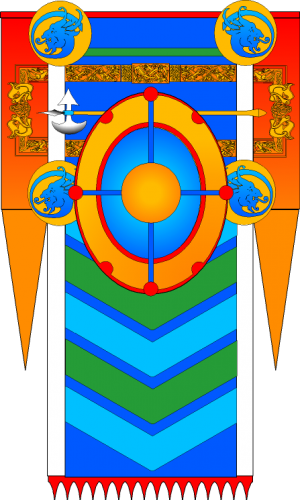Difference between revisions of "Medibgö"
Trismegistus (talk | contribs) m (→Meidb) |
Trismegistus (talk | contribs) m (→See Also) |
||
| (11 intermediate revisions by the same user not shown) | |||
| Line 1: | Line 1: | ||
[[File:FlagEmpireMedibgöCivilian.png|thumb|200px|Peacetime flag of the Empire of Medibgö]] | [[File:FlagEmpireMedibgöCivilian.png|thumb|200px|Peacetime flag of the Empire of Medibgö]] | ||
[[File:FlagEmpireMedibgöMilitary.png|thumb|200px|Military flag of the Empire of Medibgö]] | [[File:FlagEmpireMedibgöMilitary.png|thumb|200px|Military flag of the Empire of Medibgö]] | ||
| − | The historic sky-nation dwelling in [[skyness]]es over southeastern [[Pytharnia]], [[Dúrandwor]], and the adjacent portion of the [[Pallathantic Sea]], Medibgö is known for its colorful pageantry, aristocrats, and history of powerful sorcerers. [[Medibgóëse Gonfaloy]] is an imperial dependency of the [[Empire of Medibgö]]. [[Kasthavia]] is an allied state. | + | The historic sky-nation dwelling in [[skyness]]es over southeastern [[Pytharnia]], [[Dúrandwor]], and the adjacent portion of the [[Pallathantic Sea]], Medibgö is known for its colorful pageantry, aristocrats, and history of powerful sorcerers. [[Medibgóëse Gonfaloy]] is an imperial dependency of the [[Empire of Medibgö]]. [[Kasthavia]] is an allied state. Medibgö properly refers to the eight orbits and their skynesses from the time of their legendary founder, [[Meidb]]. Before this time, they are referred to by the [[Kalama]]n (Jathya-Dhumi) Name, [[Aksiluva]]. |
The Empire of Medibgö is historically closely tied to the [[Empire of Magdala]] as part of the [[Union of Pytharnia]]. In standard usage, the term 'Empire of Medibgö' refers to the state and 'Medibgóëse Empire' refers to the empire during the period of its great power in the twenty fifth century. | The Empire of Medibgö is historically closely tied to the [[Empire of Magdala]] as part of the [[Union of Pytharnia]]. In standard usage, the term 'Empire of Medibgö' refers to the state and 'Medibgóëse Empire' refers to the empire during the period of its great power in the twenty fifth century. | ||
| Line 25: | Line 25: | ||
==Medibgö as Refuge for Magic-Practitioners== | ==Medibgö as Refuge for Magic-Practitioners== | ||
[[File:WizardSkullcap.jpg|thumb|200px|The [[Ffwrsva]] or wizard's skullcap]] | [[File:WizardSkullcap.jpg|thumb|200px|The [[Ffwrsva]] or wizard's skullcap]] | ||
| − | During the High and Late [[Yophenthean Empire]], sorcery was a capital crime and Medibgö received refugees who were permitted to practice wizardry openly in the skynesses of Medibgö. Since land in the sky was at a premium, only the best sorcerers were admitted. Other refugees lived in [[Jaibu|jaibus]] or served in the houses of Medibgóëse nobles. The Yophenthean rulers could not directly oppose this and adopted an unofficial policy of tolerance. | + | During the High and Late [[Yophenthean Empire]], sorcery was a capital crime and Medibgö received refugees who were permitted to practice wizardry openly in the [[skynesses of Medibgö]]. Since land in the sky was at a premium, only the best sorcerers were admitted. Other refugees lived in [[Jaibu|jaibus]] or served in the houses of Medibgóëse nobles. The Yophenthean rulers could not directly oppose this and adopted an unofficial policy of tolerance. |
==Settlement of Gonfaloy== | ==Settlement of Gonfaloy== | ||
| + | {{Main|Settlement of Gonfaloy}} | ||
In the late 13th century (ca 1280), the Medibgösk suffered from excessive population and malcontents. These were sent to colonize a peninsula in southwestern Pytharnia known today as [[Gonfaloy]]. The [[Gonfalese Language]], spoken in Gonfaloy and the [[Durrhaunve Valley]], is directly related to the [[Medibgóëse Language]]. It is the principal language of the [[Principality of Gonfaloy]], [[Medibgóëse Gonfaloy]], the [[Archpatriarchy of Ambrasia]], the Asbardian-ruled [[Flisbardy]], and three Principalities in the Empire of Magdala, namely the [[Duchy of Flamander]], the [[March of Amosgire]], and the [[Duchy of Ygdafyl]]. | In the late 13th century (ca 1280), the Medibgösk suffered from excessive population and malcontents. These were sent to colonize a peninsula in southwestern Pytharnia known today as [[Gonfaloy]]. The [[Gonfalese Language]], spoken in Gonfaloy and the [[Durrhaunve Valley]], is directly related to the [[Medibgóëse Language]]. It is the principal language of the [[Principality of Gonfaloy]], [[Medibgóëse Gonfaloy]], the [[Archpatriarchy of Ambrasia]], the Asbardian-ruled [[Flisbardy]], and three Principalities in the Empire of Magdala, namely the [[Duchy of Flamander]], the [[March of Amosgire]], and the [[Duchy of Ygdafyl]]. | ||
| Line 34: | Line 35: | ||
==Rule of Chaos Mages== | ==Rule of Chaos Mages== | ||
| − | Medibgö like most of the Pallathantic, suffered from the rule of capricious chaos wizards. Through the late [[Middle Ages of Chaos]], there was no single rule of all the Great Skynesses. The most powerful of them was [[Ddägduch Lord of the Flying Earth]] who received exiled dragon knights fleeing from [[Archmage Bexaloth]]. | + | Medibgö like most of the Pallathantic, suffered from the rule of capricious chaos wizards. Through the late [[Middle Ages of Chaos]], there was no single rule of all the Great Skynesses. The most powerful of them was [[Ddägduch Lord of the Flying Earth]] who received exiled dragon knights fleeing from [[Archmage Bexaloth]]. Other rulers included [[Eriwerg of the Passions]], [[Gwämbysin of the Throes]], and [[Llŵmbo the Scintillant]]. |
==Medibgóëse Empire== | ==Medibgóëse Empire== | ||
| Line 71: | Line 72: | ||
*Emperor: Gebal, Gebalddorn (Hereditary Heir of the Emperor). The Imperial family is chosen by the Thörewgas. | *Emperor: Gebal, Gebalddorn (Hereditary Heir of the Emperor). The Imperial family is chosen by the Thörewgas. | ||
| + | *Archmage | ||
| + | *Dragonmasterlord | ||
*Duke: Tüdd, Tüddorn (hereditary son of Duke) (Thörewgas). A duke can potentially become Emperor. Anciently, a duke could create a count or a viscount in his own right. Historically, a ruling Duke is the ruler of a [[Great Skynesses of Medibgö|Great Skyness of Medibgö]] and requires the power to create Counties and Viscounties for the satellite skynesses of his domain. | *Duke: Tüdd, Tüddorn (hereditary son of Duke) (Thörewgas). A duke can potentially become Emperor. Anciently, a duke could create a count or a viscount in his own right. Historically, a ruling Duke is the ruler of a [[Great Skynesses of Medibgö|Great Skyness of Medibgö]] and requires the power to create Counties and Viscounties for the satellite skynesses of his domain. | ||
*Count: Gnäw, Gnäwddorn (hereditary son of Count) (Thörewgas) Anciently, a count could create a baron to serve him. | *Count: Gnäw, Gnäwddorn (hereditary son of Count) (Thörewgas) Anciently, a count could create a baron to serve him. | ||
| Line 78: | Line 81: | ||
=See Also= | =See Also= | ||
| + | *[[Empire_of_Medibgö#Aristocratic_Ranks|Aristocratic Ranks of Medibgö]] | ||
*[[Chronology of Medibgö]] | *[[Chronology of Medibgö]] | ||
*[[Empire of Magdala]] | *[[Empire of Magdala]] | ||
| − | |||
*[[Great Skynesses of Medibgö]] | *[[Great Skynesses of Medibgö]] | ||
*[[List of the Emperors of Medibgö]] | *[[List of the Emperors of Medibgö]] | ||
| + | *[[List of the Rulers of Medibgö]] | ||
*[[Mäddglows]] | *[[Mäddglows]] | ||
*[[Medibgóëse Language]] | *[[Medibgóëse Language]] | ||
*[[Medibgösk Gods and Religion]] | *[[Medibgösk Gods and Religion]] | ||
*[[Meidb]] | *[[Meidb]] | ||
| + | *[[Portal:Medibgö]] | ||
*[[Skynesses of Medibgö]] | *[[Skynesses of Medibgö]] | ||
*[[Thörewgas]] | *[[Thörewgas]] | ||
Latest revision as of 18:08, 4 February 2019
The historic sky-nation dwelling in skynesses over southeastern Pytharnia, Dúrandwor, and the adjacent portion of the Pallathantic Sea, Medibgö is known for its colorful pageantry, aristocrats, and history of powerful sorcerers. Medibgóëse Gonfaloy is an imperial dependency of the Empire of Medibgö. Kasthavia is an allied state. Medibgö properly refers to the eight orbits and their skynesses from the time of their legendary founder, Meidb. Before this time, they are referred to by the Kalaman (Jathya-Dhumi) Name, Aksiluva.
The Empire of Medibgö is historically closely tied to the Empire of Magdala as part of the Union of Pytharnia. In standard usage, the term 'Empire of Medibgö' refers to the state and 'Medibgóëse Empire' refers to the empire during the period of its great power in the twenty fifth century.
Medibgóëse Society
The social strata of Medibgö are very divided between the masters and the servants. A middle or merchant class as such is virtually non-existent. The divide has become so great that the spoken language of the servants is remarkably different from that of their masters. Servants do not receive the same names as the masters. The reason for this great divide is that Medibgö is comprised of skynesses and the total surface area is very little compared to conventional surface nations. Even mountain-locked nations have more land. For this reason, the skynesses are the residence of aristocratic houses and their households.
Dragonmount Warfare
Medibgö has a long history of practicing dragonmount warfare, inherited from the Neptultchi Dragon Knights who once made their domains among its skynesses. The profession of dragonmount knight remains a viable option for men who wish to advance and lack the aptitude or inclination for wizardry. Medibgö received the dragonmount warriors who fled from Bexaloth, Archmage of Bryndyd. These warriors greatly enhanced the practice of dragonmount warrior in Medibgö. After the death of Bexaloth, most of these warriors returned to Asbardy, but some remained, and others still settled in other places in southern Pytharnia.
History
The History of Medibgö extends over some nearly three thousand years from the life of the legendary founder, Meidb. The history of the great skynesses before Meidb is the history of Aksiluva. The greatest quantity of historical records abound in the twenty fifth century from which time there has been no significant disruption in the transmission and preservation of the records. Few records survive from before the Yophenthean Period and many records were destroyed or lost during the Middle Ages of Chaos.
Meidb
The legendary founder of Medibgö was Meidb, the son of the god Rhio and the Elamahti woman, Safreti. Rhio is thus the national god of Medibgö. Meidb is the namesake of Medibgö which means 'Nation of Meidb' in Medibgóëse. According to legend, Meidb taught princes of the Tigskö tribe sorcery and led them to defeat the Neptultchi Dragon-Knight rulers of the skynesses of Aksiluva. The sky-islands were thereafter called 'Medibgö', nation of Meidb in his honor. Modern Historians believe that Meidb may be a creation of a later age and it is doubtful that all the skynesses were conquered at once. Modern historians believe the Neptultchi Dragon-Knights gradually absorbed and became cultural infused into waves of Kasthavian immigrants. Dragonmount warfare remains an integral part of Medibgóëse civilization, historically and at present. The theory with the most currency is that the immigrating Kasthavians became the ruling class, making the dragon knights their vassals. The princes of the various skynesses became attached to a common ancestral cult in Mäddglows where the god Rhio represented the power of the unifying sun. During the Yophenthean (or "Arathracian") period, the sun god, Am, rose in political importance as the relationship between Rhio and Arathrax became the religious basis for the relationship between Medibgö and Yophenthea.
Yophenthean Medibgö
In 599 AI, the princes of Medibgö became subjects of the Yophenthean Priest-King ("Erreach") as this was during the Unified Monarchy.
Medibgö as Refuge for Magic-Practitioners

During the High and Late Yophenthean Empire, sorcery was a capital crime and Medibgö received refugees who were permitted to practice wizardry openly in the skynesses of Medibgö. Since land in the sky was at a premium, only the best sorcerers were admitted. Other refugees lived in jaibus or served in the houses of Medibgóëse nobles. The Yophenthean rulers could not directly oppose this and adopted an unofficial policy of tolerance.
Settlement of Gonfaloy
In the late 13th century (ca 1280), the Medibgösk suffered from excessive population and malcontents. These were sent to colonize a peninsula in southwestern Pytharnia known today as Gonfaloy. The Gonfalese Language, spoken in Gonfaloy and the Durrhaunve Valley, is directly related to the Medibgóëse Language. It is the principal language of the Principality of Gonfaloy, Medibgóëse Gonfaloy, the Archpatriarchy of Ambrasia, the Asbardian-ruled Flisbardy, and three Principalities in the Empire of Magdala, namely the Duchy of Flamander, the March of Amosgire, and the Duchy of Ygdafyl.
Medibgösk Empire
Medibgö was first united under a single imperial monarchy in the nineteenth century (1817) under Ffaddgiól I who was suzerain over the various princes of the skynesses of Medibgö. This differed from the previous monarchs who were merely sorcerer-kings.
Rule of Chaos Mages
Medibgö like most of the Pallathantic, suffered from the rule of capricious chaos wizards. Through the late Middle Ages of Chaos, there was no single rule of all the Great Skynesses. The most powerful of them was Ddägduch Lord of the Flying Earth who received exiled dragon knights fleeing from Archmage Bexaloth. Other rulers included Eriwerg of the Passions, Gwämbysin of the Throes, and Llŵmbo the Scintillant.
Medibgóëse Empire
During the twenty fifth century after the recovery from the Isbajutha, the wizards of Medibgö ruled Pytharnia and much of the Pallathantic. This is often considered the high point of Medibgóese Civilization and its influence persists today. During this time, the emperor would appoint Prince-Governors to rule different regions of the empire.
Legacy of Medibgóëse Empire
Language
The Medibgóëse Language remains the most commonly used tongue for diplomacy, international commerce, and many academic publications. The Medibgóëse System of Measurement is also employed widely in international trade and treaties. Many important works of magic, metamagical treatises, and magical history are written in Medibgóëse and the understanding of it is critical for any advanced student of formal wizardry.
Religion
The historic religion of Medibgö is an indigenous solar cult centered on Rhio with some roles for Amrulon and Arathrax. The rescue of Rhewlla (compare Rhio) is a religious theme celebrated on Winter Solstice which is the last day of the sacred year (see Arathracian Calendar). Medibgösk Sun Cult is an expression of the Old Religion of the Isxinthion Gods and was tolerated during the Yophenthean Empire. The solar cult practices of Ambrasia are derived in part from the sun worship of Medibgö. The present-day Emperor of Medibgö is the highest representative of the ancestral god, Rhewlla, in Medibgö. The eponymous ancestor, Meidb, regarded as a son of Rhewlla is also greatly honored.
Medibgóëse Language
The Medibgóese Language is official and predominant language of the skynesses and jaibus of the Medibgóëse Empire. It is derived from Old Colnorian with a very strong element of Pytharnian. Some 40% of all words in the language are from Pytharnian. The Gonfalese Language is derived from Medibgóëse.
Notes
- Meidbgö: National Name (Meidbgö)
- Mämnir, skyness capital of Medibgö
- Mäddglows: “Mediclose,” Imperial skyness capital of Medibgö
- Thörewgas, upper house of Empire of Magdala—constituted of Medibgóëse Peers
Imperial Family
While the glory days of Medibgö's prime have waned, the empire wields great influence among nations of sky and earth. The Royal Emperor Talvan VII rules from the Ffarfaddagh Throne in the imperial capital of Mäddglows. The emperor must share his 'supreme' power with the aristocrats and guilds of his realm. He wields many of the rights typical of kingship.
Medibgö lacks a central skyforce. Instead, the guilds and nobles must yield their forces to the imperial monarch at his behest. This is the result of a previous settlement when a former emperor agreed to disband the imperial skyforce in exchange for the dissolution of the aristocratic council.
Medibgö is one of the three powers that comprises the Union of Pytharnia and holds the prestigious power of the Thörewgas, the upper house of the of the Empire of Magdala.
Emperor Talvan's eldest child is the Princess Arewlein, aged 23, as yet unwed. The Gebalddorn (imperial heir) is Prince Medalgo, aged 15. Recently, the Empress Galibé has stayed away from public engagements and rumors suggest she has fallen seriously ill.
Ranks of Emperor and Aristocrats
Medibgóëse aristocrats consist of five ranks. The four highest ranks possess seats in the Thörewgas. Currently about two dozen aristocrats rule domains in their own rights as vassals of the emperor. All Medibgóëse aristocratic families practice wizardry. Nobles consider excellence in the spellcasting arts to be superior than martial pursuits and leave conventional warfare to Dragon Knights and Pytharnians. Conversely Dragon Knights of Medibgö of great ability with pair their military prowess with specially prepared wizardry designed to enhance their training as a dragon knight.
- Emperor: Gebal, Gebalddorn (Hereditary Heir of the Emperor). The Imperial family is chosen by the Thörewgas.
- Archmage
- Dragonmasterlord
- Duke: Tüdd, Tüddorn (hereditary son of Duke) (Thörewgas). A duke can potentially become Emperor. Anciently, a duke could create a count or a viscount in his own right. Historically, a ruling Duke is the ruler of a Great Skyness of Medibgö and requires the power to create Counties and Viscounties for the satellite skynesses of his domain.
- Count: Gnäw, Gnäwddorn (hereditary son of Count) (Thörewgas) Anciently, a count could create a baron to serve him.
- Viscount: Llawbgnäw, Llawbgnäwddorn (hereditary son of Viscount) (Thörewgas)
- Baron: Brabam, Brabamnorn (hereditary son of Baron) (Thörewgas)
- Seigneur: Sklädborn, Sklädborddorn (hereditary son of Seigneur) (no seat in Thörewgas)
See Also
- Aristocratic Ranks of Medibgö
- Chronology of Medibgö
- Empire of Magdala
- Great Skynesses of Medibgö
- List of the Emperors of Medibgö
- List of the Rulers of Medibgö
- Mäddglows
- Medibgóëse Language
- Medibgösk Gods and Religion
- Meidb
- Portal:Medibgö
- Skynesses of Medibgö
- Thörewgas
| This article is a stub. It requires further development by the creator. |


